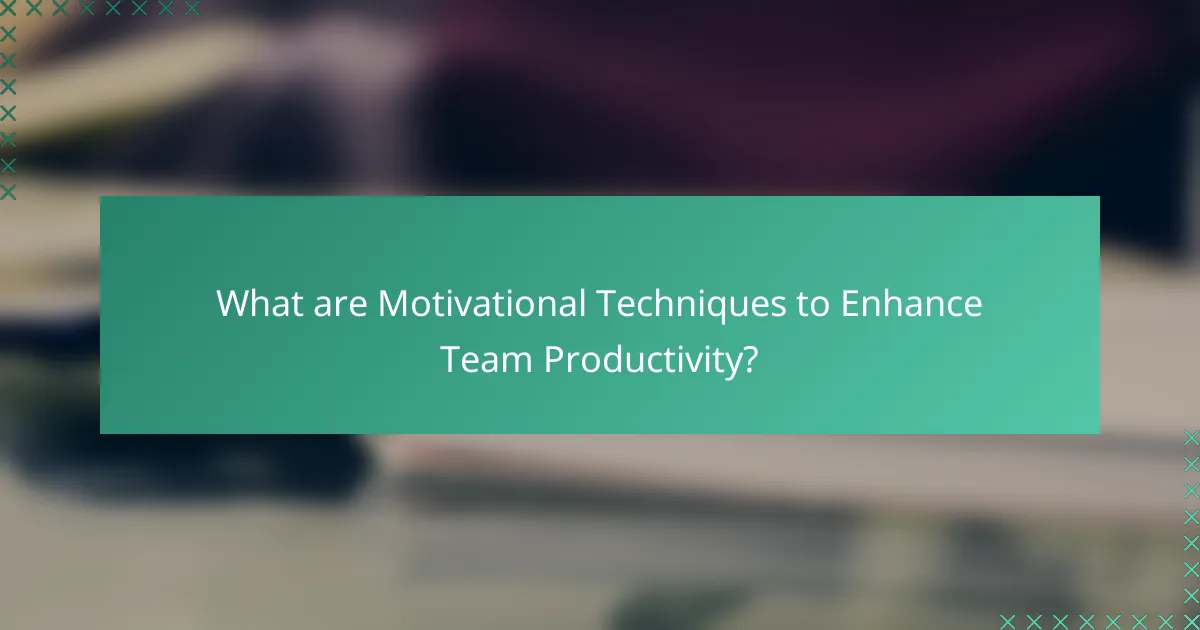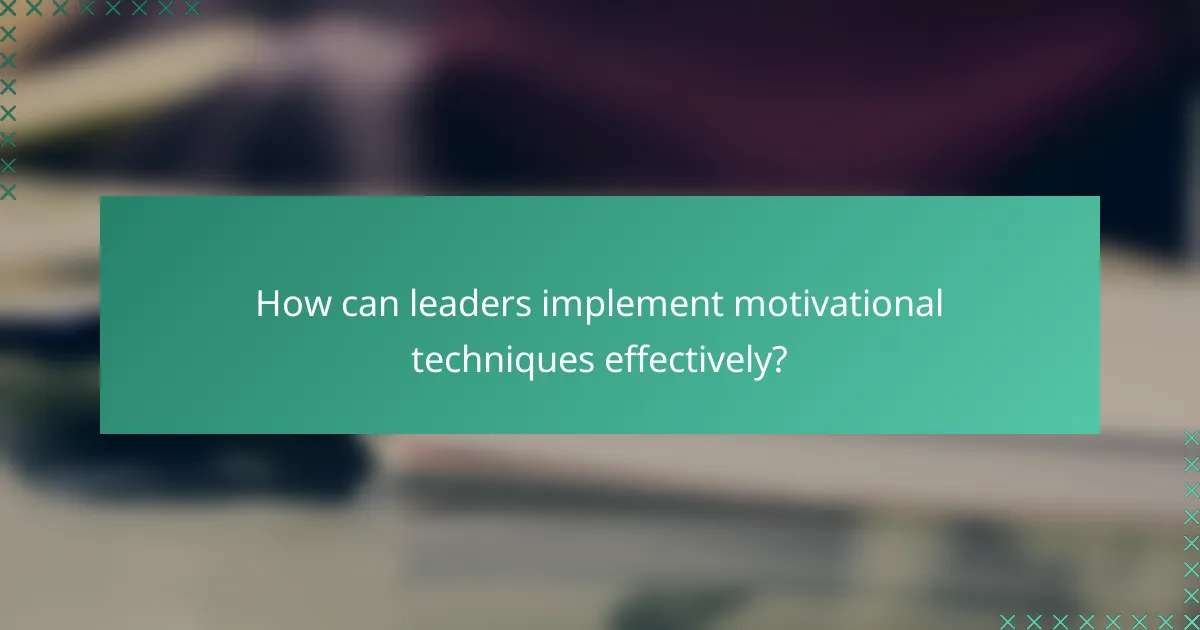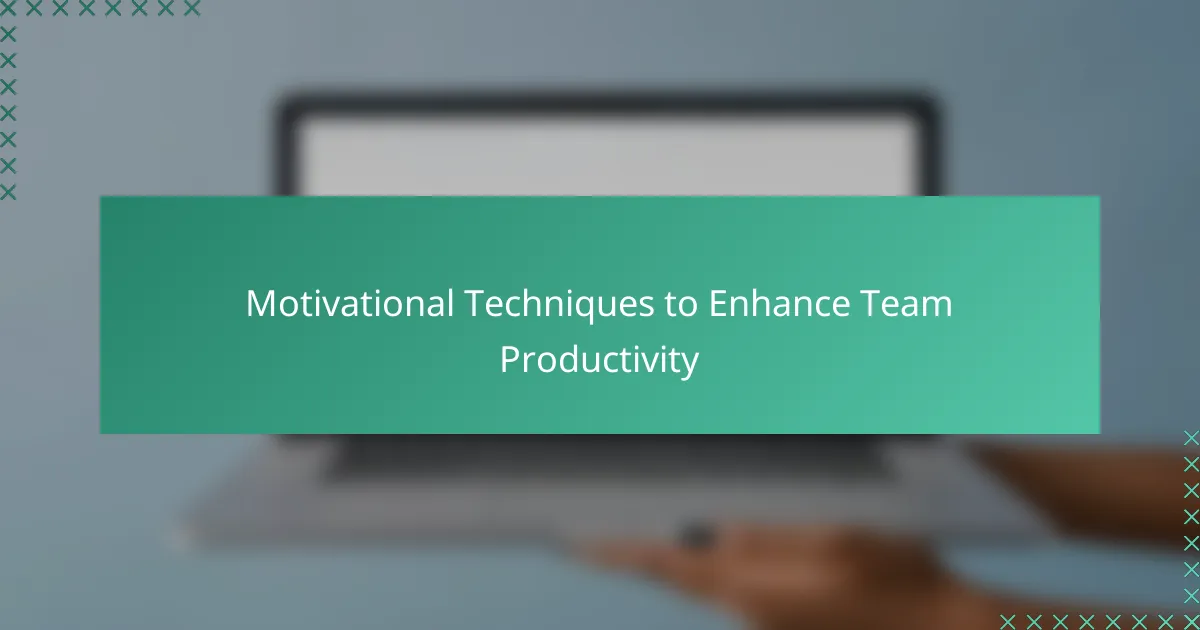Motivational techniques are strategies implemented to enhance team productivity by fostering engagement and performance. Key methods include setting clear goals, providing regular feedback, recognizing achievements, and creating a collaborative culture. Research indicates that engaged employees can lead to productivity increases of up to 17% and higher profitability. Effective leadership practices involve establishing objectives, offering positive reinforcement, promoting autonomy, and investing in professional development. By adopting these techniques, organizations can significantly improve team performance and overall productivity.

What are Motivational Techniques to Enhance Team Productivity?
Motivational techniques to enhance team productivity include setting clear goals, providing regular feedback, and recognizing achievements. Clear goals give team members a sense of direction and purpose. Regular feedback helps individuals understand their progress and areas for improvement. Recognition of achievements fosters a positive environment and encourages continued effort.
Research shows that companies with engaged employees can see productivity increase by up to 17% (Gallup, 2020). Additionally, creating a collaborative team culture can further enhance productivity. When team members feel valued and connected, their motivation increases.
Implementing these techniques can lead to significant improvements in team performance and overall productivity.
How do motivational techniques impact team dynamics?
Motivational techniques significantly enhance team dynamics. They foster collaboration and improve communication among team members. Techniques such as recognition and rewards boost morale and increase engagement. This leads to a more positive work environment. Research shows that teams with high motivation levels are 21% more productive. Additionally, motivated teams exhibit lower turnover rates. This stability contributes to stronger team cohesion. Overall, effective motivational strategies create a culture of trust and support within teams.
What psychological principles underpin these techniques?
Motivational techniques to enhance team productivity are underpinned by several psychological principles. These principles include Maslow’s Hierarchy of Needs, which suggests that individuals are motivated by fulfilling basic needs before higher-level psychological needs. Another principle is the Self-Determination Theory, which emphasizes the importance of autonomy, competence, and relatedness in fostering intrinsic motivation. Additionally, the Expectancy Theory posits that individuals are motivated by the expected outcomes of their efforts, linking motivation to perceived likelihood of success. Research shows that applying these principles can lead to increased engagement and productivity within teams. For instance, a study by Deci and Ryan (2000) highlights how fulfilling psychological needs enhances motivation and performance.
How do different team environments influence motivation?
Different team environments significantly influence motivation. Collaborative environments foster a sense of belonging. This enhances individual commitment to team goals. Research shows that supportive team dynamics increase motivation by 30%. In contrast, competitive environments can lead to stress and decreased morale. High-pressure settings often reduce intrinsic motivation. A study by Deci and Ryan highlights that autonomy in teams boosts motivation. Teams with clear communication channels report higher engagement levels. Effective leadership within teams also plays a crucial role in maintaining motivation.
Why are motivational techniques essential for team productivity?
Motivational techniques are essential for team productivity because they enhance engagement and performance. Engaged team members are more likely to contribute effectively. According to a Gallup study, highly engaged teams show 21% greater profitability. Motivational techniques also foster a positive work environment. A supportive atmosphere leads to increased collaboration and creativity. Furthermore, motivation helps reduce employee turnover. High turnover can cost companies significantly, with estimates suggesting it can reach up to 200% of an employee’s salary. Overall, motivational techniques drive better results and improve overall team dynamics.
What measurable outcomes result from increased team motivation?
Increased team motivation leads to higher productivity levels. Motivated teams often achieve more in less time. This improvement can be quantified through performance metrics. Studies show that motivated employees can increase output by up to 20%. Additionally, team motivation correlates with reduced absenteeism. Companies with motivated teams experience a 41% reduction in absenteeism rates. Furthermore, increased motivation enhances employee engagement. Engaged employees are 87% less likely to leave their jobs. Overall, measurable outcomes from increased team motivation include higher productivity, lower absenteeism, and improved employee retention.
How does motivation correlate with employee satisfaction and retention?
Motivation directly influences employee satisfaction and retention. Higher motivation leads to increased job satisfaction among employees. Satisfied employees are more likely to remain with their organization. According to a study by Gallup, organizations with highly engaged employees see 21% greater profitability. Additionally, motivated employees tend to exhibit lower turnover rates. The same Gallup research indicates that disengaged employees are 87% more likely to leave their jobs. This correlation underscores the importance of motivation in fostering a stable workforce.

What types of motivational techniques can be used?
Various motivational techniques can be used to enhance team productivity. Common techniques include goal setting, which provides clear objectives for team members. Positive reinforcement is another technique, rewarding desired behaviors to encourage repetition. Team-building activities foster collaboration and strengthen relationships among team members. Providing autonomy allows individuals to take ownership of their work, increasing motivation. Regular feedback helps team members understand their performance and areas for improvement. Recognition and rewards for achievements boost morale and encourage continued effort. Training and development opportunities enhance skills and show investment in team members. These techniques are supported by research indicating that motivated teams are more productive and engaged.
How do intrinsic and extrinsic motivators differ?
Intrinsic motivators are internal factors that drive individuals to perform an activity for its own sake. These include personal satisfaction, interest, and a sense of achievement. Extrinsic motivators are external rewards that influence behavior, such as money, praise, or promotions. Research indicates that intrinsic motivation often leads to higher engagement and creativity. In contrast, extrinsic motivation can be effective for tasks requiring compliance or short-term performance. Studies show that intrinsic motivators generally result in more sustainable motivation compared to extrinsic ones, which can diminish over time if not regularly reinforced.
What are examples of intrinsic motivation techniques?
Examples of intrinsic motivation techniques include setting personal goals, fostering autonomy, and providing meaningful feedback. Personal goals encourage individuals to pursue tasks that align with their interests. Autonomy allows team members to make choices in their work, enhancing their sense of ownership. Meaningful feedback helps individuals understand their progress and fosters a growth mindset. Research shows that intrinsic motivation leads to higher engagement and productivity. A study by Deci and Ryan highlights the importance of autonomy and competence in enhancing intrinsic motivation.
What are some effective extrinsic motivation strategies?
Effective extrinsic motivation strategies include rewards, recognition, and competition. Rewards can be financial bonuses or gift vouchers. Recognition involves publicly acknowledging achievements, which boosts morale. Competition can be fostered through friendly contests with prizes. According to a study by Deci, Koestner, and Ryan, extrinsic rewards can enhance motivation when aligned with intrinsic goals. Implementing these strategies can lead to increased productivity and engagement in teams.
What role does recognition play in motivation?
Recognition plays a crucial role in motivation. It reinforces positive behavior and boosts self-esteem. When individuals receive acknowledgment for their efforts, they feel valued. This validation encourages them to maintain or increase their performance. Studies show that recognition can lead to higher job satisfaction. For instance, a report by Gallup found that employees who receive regular recognition are more productive. They are also more engaged in their work. Thus, recognition directly influences motivation and overall team productivity.
How can recognition be effectively implemented in teams?
Recognition can be effectively implemented in teams through regular and specific acknowledgment of individual and team achievements. This approach fosters a positive work environment and enhances motivation. Implementing peer-to-peer recognition programs encourages team members to appreciate each other’s contributions. Using both formal and informal recognition methods ensures diverse acknowledgment styles. For example, public recognition during meetings can boost morale. Additionally, personalized notes or messages can create a lasting impact. Research shows that 79% of employees who receive recognition are more motivated to work harder. This data supports the effectiveness of recognition in improving team productivity.
What are the long-term effects of recognition on team productivity?
Recognition positively impacts team productivity over the long term. It fosters a culture of appreciation and boosts employee morale. High morale leads to increased motivation and engagement in work tasks. Engaged employees tend to perform better and contribute more effectively to team goals. Research shows that organizations with recognition programs experience a 14% increase in productivity. Additionally, recognition reduces employee turnover rates, which helps maintain a stable and experienced workforce. A stable workforce further enhances teamwork and collaboration. Overall, consistent recognition cultivates a productive environment that benefits both employees and the organization.

How can leaders implement motivational techniques effectively?
Leaders can implement motivational techniques effectively by establishing clear goals and providing regular feedback. Clear goals give team members direction and purpose. Regular feedback helps individuals understand their progress and areas for improvement.
Additionally, leaders should recognize and reward achievements to reinforce positive behavior. Recognition can boost morale and encourage continued effort. Creating a supportive environment where team members feel valued is also crucial.
Moreover, leaders can promote autonomy by allowing team members to make decisions related to their work. This fosters ownership and accountability. Providing opportunities for professional development can further motivate employees.
Research shows that motivated teams are more productive. According to a study by Gallup, organizations with engaged employees see 21% higher profitability. Therefore, implementing these techniques can lead to significant improvements in team performance.
What are best practices for fostering a motivated team environment?
Best practices for fostering a motivated team environment include clear communication, recognition of achievements, and fostering collaboration. Clear communication ensures that team members understand their roles and expectations. It promotes transparency and builds trust within the team. Recognition of achievements boosts morale and encourages continued effort. Acknowledging both individual and team successes fosters a positive atmosphere. Fostering collaboration encourages teamwork and innovation. When team members work together, they share ideas and support each other, enhancing motivation. Implementing regular feedback sessions helps identify areas for improvement and reinforces positive behaviors. Studies show that motivated teams are 21% more productive, highlighting the importance of these practices.
How can leaders tailor techniques to individual team members?
Leaders can tailor techniques to individual team members by assessing their unique strengths and weaknesses. Understanding each member’s skills allows leaders to assign tasks that align with their abilities. Personalized feedback can enhance motivation and performance. Leaders should also consider individual communication styles to improve engagement. Regular one-on-one meetings can help identify personal goals and challenges. By adapting leadership styles to fit each team member, leaders foster a supportive environment. Research shows that personalized approaches lead to higher job satisfaction and productivity. Tailoring techniques ultimately drives team success and cohesion.
What tools can leaders use to measure motivation levels?
Leaders can use surveys and questionnaires to measure motivation levels. These tools allow for anonymous feedback from team members. They can include Likert scale questions to quantify feelings about work. Regular pulse surveys can track changes in motivation over time. Performance metrics can also serve as indicators of motivation. High productivity often correlates with high motivation. One-on-one meetings provide qualitative insights into individual motivation. Tools like 360-degree feedback offer comprehensive perspectives on team dynamics. These methods provide valuable data for leaders to assess and enhance motivation.
What challenges might arise when applying motivational techniques?
Challenges that may arise when applying motivational techniques include resistance from team members. Individuals may be skeptical about the effectiveness of these techniques. Some may perceive them as insincere or manipulative. Additionally, motivational techniques can lead to uneven results among team members. Different individuals respond variably to motivational strategies. This variability can create disparities in team dynamics. Lack of personalization in techniques may also hinder their effectiveness. A one-size-fits-all approach often fails to address unique individual needs. Furthermore, over-reliance on external motivators can diminish intrinsic motivation. This can result in a lack of long-term engagement and commitment.
How can resistance to motivation strategies be addressed?
Resistance to motivation strategies can be addressed through targeted communication and engagement. Understanding individual team members’ needs is crucial. Regular feedback sessions can help identify concerns. Tailoring motivation strategies to align with personal goals enhances acceptance. Providing training on the benefits of motivation techniques fosters openness. Using data-driven approaches can demonstrate the effectiveness of strategies. Encouraging a culture of collaboration reduces resistance. Engaging team members in the development of motivation strategies increases buy-in.
What are common pitfalls in implementing motivational techniques?
Common pitfalls in implementing motivational techniques include lack of alignment with team values. When techniques do not resonate with team members, they fail to inspire. Another pitfall is inconsistent application of motivational strategies. This inconsistency can lead to confusion and distrust among team members. Additionally, overemphasis on monetary rewards can diminish intrinsic motivation. Studies show that intrinsic motivation is crucial for long-term engagement. Poor communication about the purpose of motivational techniques can also hinder their effectiveness. When team members do not understand the rationale, they may resist participation. Lastly, neglecting individual differences can result in a one-size-fits-all approach. Tailoring techniques to individual preferences is essential for success.
What practical tips can enhance the effectiveness of motivational techniques?
To enhance the effectiveness of motivational techniques, set clear and achievable goals. Clear goals provide direction and purpose. Regularly acknowledge and reward achievements to reinforce positive behavior. Recognition boosts morale and encourages continued effort. Create a supportive environment that fosters open communication. This encourages team members to express their ideas and concerns. Utilize diverse motivational strategies tailored to individual preferences. Personalization increases engagement and effectiveness. Provide opportunities for skill development and growth. Continuous learning enhances confidence and motivation. Regularly solicit feedback to assess the impact of motivational techniques. This allows for adjustments based on team needs.
Motivational techniques are strategies aimed at enhancing team productivity by fostering engagement and performance among team members. Key techniques include setting clear goals, providing regular feedback, recognizing achievements, and promoting a collaborative culture. The article explores the impact of these techniques on team dynamics, the psychological principles behind motivation, and the measurable outcomes of increased motivation, such as higher productivity and lower turnover rates. Additionally, it addresses the role of intrinsic and extrinsic motivators, practical tips for effective implementation, and common challenges faced by leaders when applying these strategies.
